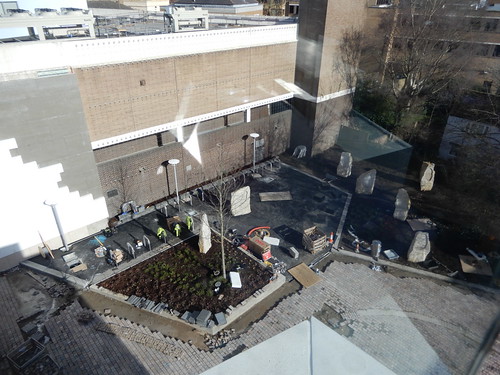Going to
Lumiere London was a bit of a last minute thing. We had other things on in the morning and piled into London late, the light already fading, squeaking it for the other thing we'd planned to do, which was visit the Rachel Whiteread show at the Tate Britain.
Bits of the London Lumiere are kind of gardeny - like anything that happens in squares and interstitial urban spaces, it feel inflorescent, like an emanation; classy planting here, and there colourful weeds.
At this time of year, my garden gets barely an hour of sun a day, smuggled uncertainly around the roofs and through the trees. I'm desperate for light in the garden. Can the Lumiere help me find some ways to bring down the sun into the gloom of a winter British garden?
1. Colourful chunks of light-capturing material

I love the luminous resinous chunkiness of these underchair spaces by Rachel Whiteread. The material on these probably isn't weatherproof, but perhaps something could be found that was? They'd sit well among greenery as a garden stool, cat chess posing stand or just as something to capture the sun and draw it down into the garden.
2. Line your windows with colour; let them shine across the water


In domestic spaces, the main source of light for any garden will be the house. But windows don't have to be neutral electric rectangles. You don't have to go to the Lumiere to see this view; it's available every night of the year. London's glassy waterfront properties line and space their windows with neon streaks and splices and then use the Thames to paint luminous rippled neon-bright pathways to their doorways. You can do the same with fairy lights around a window, or a
neon floor lamp inside a glass door, in a window box; and use some water in the garden to pull down the sky and the light, or beat a pathway to your neon-lit window.
3. Extend your lights with diffusing additions

This one looked easy enough to make I wondered if it was a local school project. It's more of a party lights item than something to have up every day of the year. The jellyfish trails are made of sliced up plastic bottles, but anything transparent can be used to trail light away from its source. Imagine this threaded through a vine; the glow of green, the snakey hint of something oozing through the undergrowth.
4. Light string your pergola


This one - wave - was incredibly compelling. You just had to walk through it. This was pretty complicated stuff - motion sensors at ankle height triggered colour changes and flashes in banks of multi-coloured LEDs. That might be a bit much for a weekend make for a summer party, but you can buy
luminescent string very easily nowadays, and that could be strung along the struts of a greenhouse, or - yes - along your pergola. The string itself is waterproof, and very low-power, you just need an AA battery pack (and a baggie for it in case it rains). Not got a pergola? Read on:
5. Light string your shrubs and perennials

Look at this! The severe silhouettes of mature London Plane trees are strung with fluorescent string lit by blacklight searchlights, as if a
70s string painting found its ultimate 21st Century apotheosis. I'm not oversupplied with mature trees or generators to run massive searchlights out back, but you could string shrubs or tall, tough perrenials (think Hollyhocks or Raspberry canes) up with more light string, and skip the searchlights. Although
waterproof blacklight strips are a thing, of course (for night fishing) and once you're getting them, you might as well throw in a few
glow-critters too.
6. Light-up woodland animals


These are light-up willow sculptures, and primary school kids learn to make them every year for winter lights festivals. These are very pretty and professional examples of the genre; most look more like
these (instructions are also through that link - but briefly, soak some willow twigs, weave them into shapes, cover with tissue paper soaked in PVA, then paint) but I think a simple hedgehog, rabbit or crow should be doable in the back-garden.
LED tea lights traditionally provide the lighting but it's easier to go brighter with a
cupboard light. The ones I just linked to have motion sensors, which could add even more excitement to your light-up wildlife.

 7. Giant solar powered flowers
7. Giant solar powered flowers
 Solar powered flowers
Solar powered flowers have come on a bit in the past few years, but there's no denying that even the best examples have a certain knee-high garden gnomish aesthetic which may not agree with you. These ones from Leicester Square have sensibly dropped the solar-powered aspect of the flower. and instead put a conventionally powered super-bright LED light in the middle and attached translucent/reflective petals. At this size they take on a threatening, dominant air. You too could intimidate your guests - with the help of some of that PVA tissue paper, a garden cane, a cupboard light and some light string, for the leaves.


























/cdn.vox-cdn.com/uploads/chorus_image/image/54387345/IMG_23752.0.jpg)
